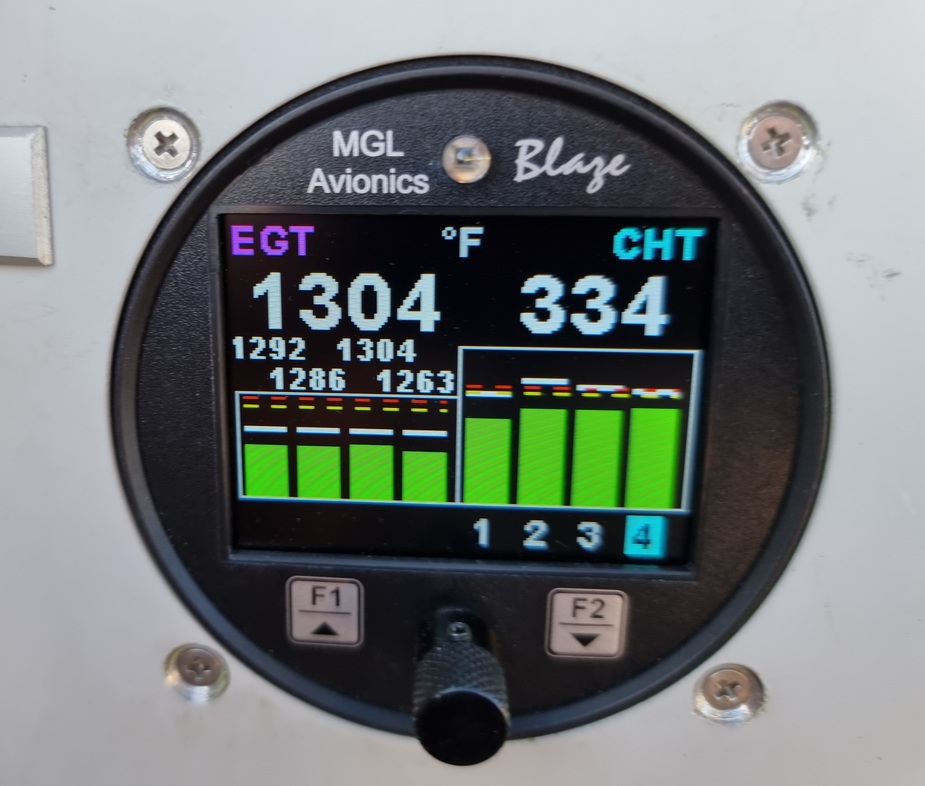My O320 has fairly even EGTs in cruise, they are usually within 30 degrees (farenheit) or so of each other.
At WOT they become hugely uneven, with #1 and #2 being much higher EGT. The #2 CHT sometimes gets about 35 degrees hotter than the others during a prolonged climb, with the highest temp seen being 415 degrees. In cruise they are usually around 330-350 or so.
EGT split during climb:

What is puzzling is why I only have the egt split at wide open throttle. The most obvious (and painful) thing I can think of is a worn forward intake lobe, but would this only affect at full throttle? The plane seems to perform normally.
The service is due so if the oil is clean I’ll need to find other things to check. Checking the valve lift should be easy enough, perhaps start there or does anyone have other suggestions?
On a carburetted engine, as opposed to a fuel-injected one, any difference between cylinders may be due to somewhat uneven mixture distribution in the intake manifold, and it’s hard to guess how it may be affected by throttle position. However, you can run a simple experiment: try cruising high enough (say, FL85 or above) at LOP WOT, with the throttle staying wide open all the time and the power being adjusted by leaning (at these altitudes it’s completely safe). See if you observe any similar difference.
My guess if it’s a carbureted engine would be a fuel distribution issue associated with the extra fuel provided by the carb only when the throttle control is in the fully open position, with the intent of holding down CHT.
You could check this by pulling back on the throttle a bit from fully open, but only until you see fuel flow do a step reduction. Then watch EGT to see if it evens out at that point. As long as CHT stays within limits this won’t hurt anything, so do it starting at moderate CHT and not after an extended climb.
In at least of their articles, one of the engine gurus (Deakin or Bush) mentioned that a partly closed throttle increases turbulence in the intake.
This could/should improve the equal fuel distribution in cases of not ideal intake designs.
(flying an injection engine, I have no own experience)
Sounds like an sample case…
I think GAMI produced a book/ paper on " EGT spread"
it might well explain what you are seeing.
I’ll see if I have a copy amongst all my rubbish but it might be quicker to Google it.
I don’t know exact construction for particular engine but in general for full throttle there can be additional jet (or variable size jet) which delivers additional fuel, like on picture below. This can be the cause of different situation of temperature spread on “normal” throttle positions and WOT.

I have just completed the service and the oil/filter was clean, so that’s good. Valve lift was consistent throughout the cylinders so I don’t think it’s a worn cam as I originally suspected.
My MA4-5 carb doesn’t have a separate jet for WOT, only the idle jet and the main jet.
Today I should have the chance to test more and then I can see at what throttle setting the EGT split reduces.
Well, it appears to just be a distribution issue related to the throttle butterfly position.
Pulling the throttle lever back about half an inch from WOT has little reduction in power but evens out the EGTs nicely:

This thread shows how little interest (or how little knowledge) there is in “engine management” in carburetted aircraft 
GAMI will sell you a set of injectors for a carb engine. It may be worth writing to GAMI and pointing them to this thread. They are very knowledgeable. I have always flown with GAMIs, but I am injected.
However this may be just a flow peculiarity further back the air path.
I have book that goes into a lot of detail on setting up and tuning Weber and Dell’Orto carburettors on cars.
In initial carburettor setup, one is advised to get the throttle butterflies perfectly parallel to the throats (i.e. throttle as open as can be) and then back them off a very tiny amount before setting the full throttle stop in place. The logic, as someone mentioned above, is that the tiniest bit of throttle introduces turbulence into the flow which continues through the intake tract and promotes the retention of an evenly-distributed mixture.
These are sidedraught carburettors, generally on inline engines, and the length / shape of the intake tract is not necessarily the same for all the cylinders. I had in the past assumed that this ‘turbulent mixing’ was mainly to overcome these inconsistencies, but it is interesting to note that the same appears to apply to an updraught carburettor feeding a four-cylinder horizontally-opposed engine with (presumably) largely identical intake tracts to all four cylinders.
I don’t really understand why, in the OPs case, it gives an inconsistency across cylinders. I would expect a fully-open throttle (totally parallel to throat) to give a slightly uneven mixture to all four cylinders.